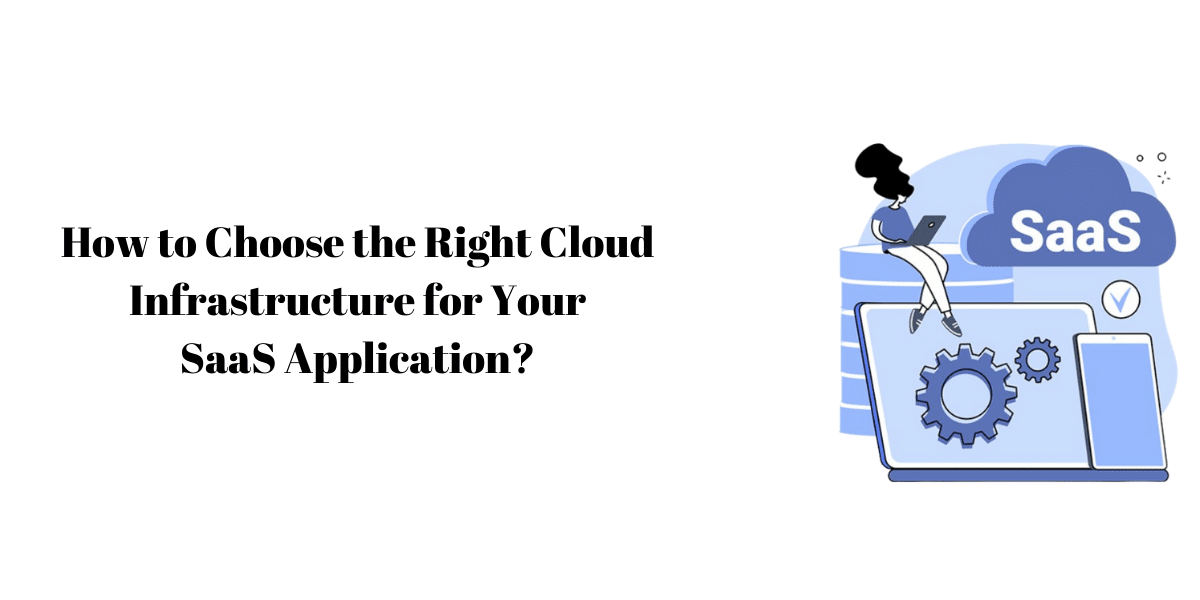In the rapidly evolving landscape of Software as a Service (SaaS), the choice of an optimal cloud infrastructure is pivotal to the success and efficiency of an application. The dynamic nature of SaaS applications demands a robust and scalable foundation, making the selection of the right cloud infrastructure a strategic decision.
This guide aims to provide a comprehensive overview and actionable insights into the essential factors one must consider when navigating the complex terrain of cloud service providers. From understanding the fundamental aspects of cloud infrastructure to delving into specific performance metrics, security considerations, and cost analyses, this resource will empower businesses and developers alike in making informed decisions.
As technology advances and user expectations grow, the importance of aligning and developing SaaS applications with the right cloud environment becomes increasingly critical. Join us on a journey to explore the key considerations that will guide you in choosing the perfect cloud infrastructure for your SaaS application, ensuring not only current success but also future resilience and scalability.
Assessing Your SaaS Application’s Requirements
Assessing the unique requirements of your Software as a Service (SaaS) application is a foundational step in the journey towards selecting an appropriate cloud infrastructure. This multifaceted evaluation involves a meticulous examination of the application’s architecture, performance expectations, and operational needs. Begin by conducting a thorough analysis of your application’s technical specifications, considering factors such as data storage, processing power, and network dependencies. Consider the anticipated user base and usage patterns to determine the scalability demands of your SaaS offering, ensuring that the chosen cloud infrastructure can seamlessly accommodate both current and future growth.
Furthermore, delve into the specific performance metrics critical to your application’s functionality. Identify key performance indicators (KPIs) such as response times, throughput, and resource utilization, aligning them with user experience expectations. Understanding the nuances of your application’s workload characteristics is essential, whether it involves heavy computational tasks, high data transfer volumes, or real-time processing requirements.
Equally important is recognizing any regulatory or compliance considerations that may influence your infrastructure choices. Depending on the industry and geographic regions you serve, compliance with data protection laws and industry regulations is paramount. Security measures, including data encryption, access controls, and threat detection mechanisms, must align with your application’s sensitivity and confidentiality requirements.
In essence, the assessment of your SaaS application development requirements is a meticulous process that demands a comprehensive understanding of both technical specifications and broader operational considerations. This knowledge forms the bedrock upon which the subsequent decisions regarding scalability, performance optimization, and security protocols will be built, ensuring a harmonious integration between your application and the selected cloud infrastructure.
Identifying Key Performance Metrics
Identifying key performance metrics is a critical facet of optimizing a Software as a Service (SaaS) application’s functionality within a cloud infrastructure. These metrics serve as the compass for gauging the health, efficiency, and responsiveness of the application. One fundamental performance indicator is response time, which directly influences user experience. Analyzing the time it takes for the application to respond to user requests provides insights into system responsiveness and can uncover potential bottlenecks.
Throughput, another vital metric, measures the rate at which the application processes transactions or data. A thorough understanding of throughput requirements ensures that the chosen cloud infrastructure can handle the anticipated workload, preventing performance degradation during peak usage periods. Concurrently, resource utilization metrics offer insights into the efficiency of resource allocation, helping to identify underutilized or overburdened components within the infrastructure.
In addition to these, error rates provide a valuable perspective on the application’s stability and reliability. Monitoring and minimizing error occurrences are crucial for ensuring a seamless user experience and preventing potential data loss or service disruptions. Scalability metrics, such as the ability to handle a growing number of users or increased data volumes, play a pivotal role in future-proofing the application, allowing it to adapt to evolving demands without compromising performance.
Ultimately, the identification of key performance metrics involves a comprehensive evaluation of various aspects, from response times and throughput to resource utilization and scalability. By meticulously scrutinizing these metrics, developers and system administrators can fine-tune the cloud infrastructure to align with the specific requirements of the SaaS application development company, fostering an environment where optimal performance and user satisfaction coalesce.
Scalability Considerations for SaaS Cloud Infrastructure
Scalability considerations constitute a cornerstone in the strategic planning of a Software as a Service (SaaS) application’s cloud infrastructure. The ability to scale seamlessly is pivotal for accommodating fluctuations in user demand and ensuring optimal performance under varying workloads. Horizontal scalability, achieved by adding more instances of resources like servers or containers, is often preferred for its flexibility and responsiveness to sudden surges in user activity. Conversely, vertical scalability involves enhancing the capacity of existing resources, catering to scenarios where a single, powerful instance is more efficient.
An essential aspect of scalability planning is anticipating the potential growth trajectory of the SaaS software solution. Robust forecasting based on historical data, market trends, and user projections enables the establishment of a scalable infrastructure that can effortlessly adapt to increasing user loads and data volumes. Load balancing mechanisms become indispensable in distributing incoming traffic across multiple servers, preventing bottlenecks and optimizing resource utilization during peak periods.
Additionally, cloud providers offer auto-scaling features that dynamically adjust resources in response to changing demand, ensuring efficient utilization while minimizing costs during periods of lower activity. Understanding the intricacies of these auto-scaling configurations and setting appropriate thresholds is paramount for achieving an optimal balance between performance and cost-effectiveness.
In essence, scalability considerations for SaaS cloud infrastructure demand a forward-looking approach, blending a deep understanding of application requirements with the agility to accommodate growth. By implementing a scalable architecture, businesses can not only enhance the user experience during peak usage but also position themselves to adapt seamlessly to the evolving demands of the market, ultimately fostering a resilient and future-proof SaaS ecosystem.
Security and Compliance in Cloud Service Selection
Security and compliance considerations are paramount when selecting a cloud service for hosting a Software as a Service (SaaS) application. The shared responsibility model inherent in most cloud environments necessitates a collaborative effort between the cloud provider and the SaaS application’s developers to ensure a robust security posture. In evaluating cloud services, it is crucial to assess the provider’s security features, including data encryption both in transit and at rest, identity and access management controls, and the effectiveness of their intrusion detection and prevention systems.
Moreover, compliance with industry regulations and data protection laws is non-negotiable. Different industries have specific compliance requirements, and ensuring alignment with these standards is imperative to avoid legal implications and protect sensitive user data. Cloud service providers often undergo third-party audits and certifications, which can serve as indicators of their commitment to maintaining high-security standards and regulatory compliance.
A comprehensive understanding of data residency and jurisdictional issues is essential, especially for global SaaS applications. Clear knowledge of where data is stored and the applicable laws in those regions helps in addressing compliance concerns and ensuring that the chosen cloud service adheres to international data protection regulations.
The integration of robust incident response and recovery mechanisms within the cloud infrastructure further enhances the security posture. Proactive monitoring, regular security audits, and continuous compliance assessments are integral components of a comprehensive security strategy when selecting a cloud service for hosting a SaaS application. By prioritizing security and compliance considerations in the cloud service selection process, organizations can build a foundation that instills trust, protects user data, and mitigates potential risks associated with operating within a cloud environment.
Cost Analysis and Budgeting for Cloud Infrastructure
Conducting a thorough cost analysis and establishing a well-defined budget is indispensable when navigating the realm of cloud infrastructure for a Software as a Service (SaaS) application. Cloud computing offers flexibility but requires careful financial planning to optimize resource allocation and control expenses effectively. A comprehensive cost analysis involves understanding the pricing models of different cloud service providers, considering factors such as compute instances, storage, data transfer, and additional services. Identifying the specific needs of the SaaS app development and aligning them with the most cost-effective services is essential for avoiding unnecessary expenditures.
Budgeting for cloud infrastructure involves not only estimating current expenses but also forecasting future growth and usage patterns. Cloud providers often offer pricing calculators to assist in predicting costs based on usage metrics. Businesses should factor in scalability requirements and potential increases in user demand to ensure that the budget remains aligned with the evolving needs of the application.
Implementing cost management tools and practices, such as tagging resources for better tracking, leveraging reserved instances for consistent workloads, and employing auto-scaling to optimize resource utilization, can contribute significantly to cost efficiency. Regularly reviewing and adjusting the budget based on actual usage and performance metrics helps in maintaining financial control and avoiding unforeseen expenses.
Furthermore, fostering a culture of cost awareness within the custom software development and operations teams is crucial. Providing training on cloud cost management and encouraging responsible resource usage ensures that all stakeholders are aligned with cost-saving objectives. In essence, a well-executed cost analysis and budgeting strategy not only prevent financial surprises but also enable businesses to harness the advantages of cloud infrastructure without compromising fiscal responsibility.
Evaluating Different Cloud Service Models
Evaluating different cloud service models is a pivotal step in selecting the most suitable infrastructure for a Software as a Service (SaaS) application. Cloud service models typically fall into three main categories: Infrastructure as a Service (IaaS), Platform as a Service (PaaS), and Software as a Service (SaaS). IaaS provides fundamental computing resources like virtual machines and storage, allowing for greater control over the operating system and applications. PaaS, on the other hand, abstracts the underlying infrastructure, providing a platform for developers to build, deploy, and manage applications without dealing with the complexities of the underlying hardware.
SaaS, the model specific to delivering software applications over the internet, offers a ready-to-use solution without the need for users to manage the underlying infrastructure, making it particularly relevant for end-users seeking efficient and accessible custom software solutions. The choice among these models hinges on the level of control and customization required by the SaaS application. Factors such as development complexity, resource management, and operational responsibilities influence the decision-making process.
Additionally, organizations need to consider whether a public, private, or hybrid cloud model aligns best with their operational and security requirements. Public clouds offer scalability and cost-effectiveness but may raise concerns about data privacy and compliance. Private clouds provide enhanced control and security but at a higher cost. Hybrid cloud solutions, combining elements of both, offer flexibility in balancing performance, control, and scalability.
Ultimately, the selection of a cloud service model hinges on the specific needs and goals of the SaaS application, with considerations ranging from infrastructure control to cost efficiency and scalability requirements. Evaluating each model’s advantages and trade-offs ensures a well-informed decision that aligns with the unique characteristics of the application and the overarching business strategy.
Choosing Between Public, Private, or Hybrid Clouds
Choosing between public, private, or hybrid clouds is a critical decision that significantly influences the performance, security, and scalability of a Software as a Service (SaaS) application. Public clouds, offered by providers like AWS, Azure, and Google Cloud, are renowned for their scalability, cost-effectiveness, and ease of access to a vast array of services. However, concerns related to data privacy, compliance, and potential resource sharing among multiple tenants may influence organizations with specific security or regulatory requirements to explore alternative options.
Private clouds, in contrast, offer dedicated infrastructure, providing greater control and customization options. This model is favored by enterprises with stringent security and compliance needs, as it ensures exclusive use of resources and enables the implementation of tailored security measures. However, the trade-off often involves higher costs and reduced scalability compared to public alternatives.
Hybrid clouds aim to strike a balance by combining elements of both public and private models. This approach allows organizations to leverage the scalability and cost benefits of public clouds for non-sensitive workloads while keeping critical applications and sensitive data within a private cloud environment. Hybrid solutions offer flexibility, enabling seamless data and workload portability between environments.
The choice among these cloud deployment models depends on various factors, including the nature of the SaaS application, data sensitivity, regulatory requirements, and budget constraints. Striking the right balance between accessibility, scalability, and security is crucial for optimizing the performance and resilience of the custom SaaS software within the chosen cloud infrastructure. Careful consideration of these factors ensures a tailored cloud deployment strategy that aligns with both technical and business objectives.
Examining Vendor Reputation and Reliability
Examining the reputation and reliability of a cloud service vendor is a crucial step in the process of selecting an optimal infrastructure for a Software as a Service (SaaS) application. The vendor’s reputation reflects its track record in delivering consistent, high-quality services and meeting customer expectations. Comprehensive research on the vendor’s history, customer testimonials, and industry reviews provides insights into their reliability and commitment to service excellence.
Reliability encompasses various facets, including the availability of services, adherence to service level agreements (SLAs), and the provider’s ability to handle unexpected outages or disruptions promptly. Analyzing historical performance data, uptime guarantees, and disaster recovery capabilities helps gauge the vendor’s commitment to providing a stable and resilient cloud environment.
Security practices are integral to reliability, and evaluating a vendor’s security measures, certifications, and compliance with industry standards is paramount. A reputable vendor should demonstrate a robust approach to data protection, encryption, and access controls, aligning with the highest security standards.
Additionally, examining the vendor’s financial stability and long-term viability is essential for ensuring a sustained partnership. A financially secure vendor is more likely to invest in cutting-edge technologies, infrastructure upgrades, and customer support, contributing to a reliable and future-proof cloud service.
In essence, a thorough examination of a cloud service vendor’s reputation and reliability involves delving into their historical performance, security practices, and financial stability. By choosing a vendor with a proven track record of reliability and a positive industry reputation, organizations can foster confidence in the stability and continuity of their SaaS application’s hosting environment.
Geographic Considerations for Data Residency and Latency
Geographic considerations for data residency and latency play a pivotal role in the selection of cloud infrastructure for a Software as a Service (SaaS) application. Data residency regulations vary across jurisdictions, and compliance with these regulations is imperative to ensure legal and regulatory obligations are met. Understanding where data is physically stored and processed is crucial, particularly in industries with stringent data protection laws. By aligning the cloud infrastructure with the geographic locations specified in relevant regulations, organizations can mitigate the risk of legal complications and data governance challenges.
Latency, the delay in data transmission between the user and the server, directly impacts the responsiveness and performance of a SaaS application. Proximity between the data center and the end-users is essential to minimize latency. Selecting a cloud service provider with data centers strategically located in close proximity to the target user base helps reduce communication delays, resulting in improved application speed and user experience. For global SaaS applications, employing a Content Delivery Network (CDN) can further enhance latency optimization by distributing content across multiple servers geographically.
Balancing data residency compliance and latency optimization requires a nuanced approach. Cloud providers offering multiple data center locations or regions enable organizations to strategically place data to comply with regulations and minimize latency for users. By factoring in these geographic considerations, businesses can ensure that their chosen cloud infrastructure not only adheres to legal requirements but also delivers an optimal user experience across diverse geographical regions.
Integration Capabilities with Existing Systems
Integration capabilities with existing systems are pivotal considerations when selecting a cloud infrastructure for a Software as a Service (SaaS) application. Seamless integration ensures that the SaaS solution can collaborate harmoniously with an organization’s current technology stack, leveraging existing investments in infrastructure and software. A comprehensive evaluation of the cloud provider’s compatibility with various databases, application programming interfaces (APIs), and middleware is essential to facilitate smooth data exchange and interoperability.
The chosen cloud infrastructure should offer robust support for common integration protocols and standards, allowing the SaaS application to connect seamlessly with enterprise systems such as Customer Relationship Management (CRM) platforms, Enterprise Resource Planning (ERP) systems, and other critical business applications. The ability to integrate with popular third-party services and tools enhances the versatility of the SaaS application and streamlines workflow efficiencies.
Furthermore, assessing the scalability of integration capabilities is crucial, especially for organizations with dynamic and evolving technology landscapes. A scalable infrastructure ensures that the SaaS application development can adapt to changing integration requirements as the business grows or as new systems are introduced. Cloud providers offering pre-built connectors, middleware solutions, and a developer-friendly environment contribute to a more straightforward and cost-effective integration process.
In summary, robust integration capabilities with existing systems form the linchpin of a successful SaaS deployment. The compatibility of the chosen cloud infrastructure with diverse technologies and the availability of tools to facilitate integration not only streamline implementation but also enhance the overall efficiency and effectiveness of the SaaS application within the broader organizational ecosystem.
Analyzing Service Level Agreements (SLAs)
Analyzing Service Level Agreements (SLAs) is a critical step in the evaluation of cloud infrastructure for hosting a Software as a Service (SaaS) application. SLAs establish the terms, expectations, and commitments between the service provider and the customer, outlining parameters such as uptime guarantees, performance metrics, and support responsiveness. Careful scrutiny of SLAs ensures that the chosen cloud service provider aligns with the operational and business needs of the SaaS application.
One key aspect to assess is the provider’s commitment to uptime and availability. SLAs typically specify a percentage of uptime, and understanding the consequences of any downtime, including compensation or service credits, is crucial. Additionally, performance metrics such as response times, throughput, and latency should be clearly defined in the SLA to ensure that the SaaS application meets user expectations.
Support and responsiveness commitments are equally vital. A well-defined SLA should outline the provider’s response times for addressing issues, the escalation process, and the availability of customer support channels. Robust SLAs reflect a provider’s confidence in their service and commitment to maintaining a high standard of performance and customer satisfaction.
Furthermore, organizations must pay attention to any clauses related to data security, privacy, and compliance within the SLA. A clear understanding of data protection measures and the provider’s adherence to industry standards and regulations is imperative for safeguarding sensitive information.
In essence, analyzing SLAs involves a meticulous examination of the terms and conditions governing the relationship between the cloud service provider and the SaaS application. A comprehensive and transparent SLA not only sets expectations but also forms the foundation for a reliable, secure, and well-supported cloud infrastructure.
Performance Monitoring and Management Tools
Effective performance monitoring and management tools are instrumental in optimizing the operation of a Software as a Service (SaaS) application within a cloud infrastructure. These tools provide real-time insights into the application’s health, responsiveness, and resource utilization, enabling proactive identification and resolution of potential issues. Comprehensive monitoring encompasses various aspects, including system performance, network latency, and application-specific metrics, allowing for a holistic view of the SaaS ecosystem.
Performance monitoring tools track key indicators such as CPU usage, memory utilization, and disk I/O, providing a granular understanding of the application’s resource consumption. Additionally, these tools often offer customizable dashboards and alerts that empower administrators to set thresholds and receive notifications when performance deviates from the expected norms.
Capacity planning is another crucial facet addressed by performance management tools. By analyzing historical performance data and trends, organizations can make informed decisions about resource allocation, scaling, and infrastructure upgrades to meet current and future demands efficiently.
Moreover, effective monitoring tools facilitate quick identification and resolution of bottlenecks or anomalies, reducing downtime and enhancing the overall user experience. Integrating log analysis and error tracking functionalities further streamlines troubleshooting processes, ensuring a rapid response to potential issues.
Cloud providers often offer native monitoring tools, and third-party solutions can be seamlessly integrated for more advanced functionalities. The choice of tools should align with the specific requirements of the SaaS application, providing actionable insights to optimize performance, enhance reliability, and support the continuous improvement of the overall user experience. In summary, robust performance monitoring and management tools are indispensable for maintaining the health, reliability, and efficiency of a SaaS application within a cloud infrastructure.
Disaster Recovery and Business Continuity Planning
Disaster recovery (DR) and business continuity planning are integral components of ensuring the resilience and reliability of a Software as a Service (SaaS) application within a cloud infrastructure. The dynamic nature of technology and unforeseen events necessitates a comprehensive strategy to mitigate the impact of disruptions. DR planning involves the development of procedures and protocols to recover IT systems and data in the event of a catastrophe, such as natural disasters, cyber-attacks, or system failures. Cloud providers typically offer geographically dispersed data centers and redundancy options, contributing to a robust DR framework by ensuring data availability and minimizing downtime.
Business continuity planning extends beyond data recovery, focusing on maintaining essential business functions during and after a disaster. This involves identifying critical processes, establishing alternative workflows, and ensuring that essential personnel have the necessary resources to continue operations. The cloud’s flexibility allows organizations to implement redundant systems, failover mechanisms, and backup strategies to minimize the impact of disruptions on business continuity.
Regular testing and simulations of disaster recovery and business continuity plans are imperative to validate their effectiveness. These exercises help identify potential weaknesses, refine procedures, and ensure that personnel are well-prepared to execute the plans when needed. Furthermore, organizations should keep abreast of emerging threats and evolving technology to adapt their strategies accordingly, ensuring the resilience of the SaaS application and overall business operations.
In essence, a robust disaster recovery and business continuity plan for a SaaS application hosted in the cloud is a strategic imperative. By leveraging the capabilities of the cloud infrastructure, organizations can fortify their ability to recover swiftly from disruptions, maintain critical functions, and sustain overall business operations with minimal impact.
Evaluating Data Backup and Retrieval Mechanisms
Evaluating data backup and retrieval mechanisms is a critical facet in ensuring the integrity, security, and recoverability of a Software as a Service (SaaS) application within a cloud infrastructure. Data, being a cornerstone of any application, requires robust backup solutions to guard against data loss due to accidental deletion, system failures, or malicious activities. Cloud service providers typically offer built-in backup and snapshot capabilities that allow organizations to create regular copies of their data at specific points in time.
An effective evaluation involves assessing the frequency and granularity of backup options to align them with the application’s specific needs. Incremental backups, differential backups, and full backups provide varying levels of granularity and efficiency, catering to different recovery scenarios. Understanding the retention policies and storage costs associated with backups is crucial for optimizing data management and controlling operational expenses.
Furthermore, evaluating the retrieval mechanisms is paramount to ensure a swift and efficient recovery process. Cloud providers often offer point-in-time recovery options, allowing organizations to roll back to a specific moment before data corruption or loss occurred. Additionally, the ease of initiating and managing data recovery processes, including the integration with disaster recovery plans, contributes to the overall resilience of the SaaS application.
Regular testing of data recovery processes, including mock restores and validation of backup integrity, is essential to confirm that the mechanisms in place align with recovery time objectives (RTOs) and recovery point objectives (RPOs). In summary, a thorough evaluation of data backup and retrieval mechanisms involves a nuanced understanding of the available options, their alignment with application requirements, and the efficiency of recovery processes, ultimately ensuring the data’s safety and continuity of the SaaS application.
Network Infrastructure and Bandwidth Requirements
Evaluating network infrastructure and bandwidth requirements is a critical aspect of optimizing the performance and reliability of a Software as a Service (SaaS) application within a cloud environment. The efficiency of the network plays a pivotal role in determining the application’s responsiveness, data transfer speeds, and overall user experience. Assessing bandwidth requirements involves understanding the volume of data exchanged between users and the application, as well as the frequency and size of data transactions. This evaluation should consider peak usage times, potential growth in user numbers, and any data-intensive features or functionalities within the SaaS application.
Choosing an appropriate cloud service provider with a global network and Content Delivery Network (CDN) capabilities can significantly enhance the application’s reach and reduce latency for users across different geographical locations. CDNs distribute content across strategically placed servers, minimizing the physical distance between users and data sources, thereby optimizing data transfer speeds.
Scalability is a crucial consideration, and cloud providers typically offer scalable bandwidth options to accommodate fluctuations in demand. Understanding the provider’s pricing model for bandwidth usage and potential associated costs is imperative for budgetary planning.
Moreover, organizations need to assess the reliability and redundancy of the network infrastructure. A robust network with failover mechanisms and redundant connections ensures continuity in the face of network outages or disruptions.
In conclusion, a comprehensive evaluation of network infrastructure and bandwidth requirements involves anticipating the current and future needs of the custom SaaS application. By aligning these requirements with the capabilities of the chosen cloud infrastructure, organizations can optimize network performance, enhance user satisfaction, and support the scalability of their SaaS application effectively.
Assessing Containerization and Orchestration Options
Assessing containerization and orchestration options is a crucial step in optimizing the deployment, scalability, and manageability of a Software as a Service (SaaS) application within a cloud infrastructure. Containerization, exemplified by technologies like Docker, allows for the encapsulation of application components and dependencies into lightweight, portable units known as containers. This approach enhances consistency across different environments and simplifies the deployment process, reducing potential compatibility issues.
Container orchestration, often achieved through platforms like Kubernetes, goes a step further by automating the deployment, scaling, and management of containerized applications. Kubernetes, for instance, provides robust features for load balancing, automated scaling, and self-healing, streamlining the operational aspects of managing a SaaS application at scale. By orchestrating containers, organizations can efficiently handle complex microservices architectures and ensure optimal resource utilization.
When assessing containerization and orchestration options, considerations should include the ease of containerization, compatibility with the chosen cloud provider, and the maturity of the orchestration platform. The ability to integrate seamlessly with other services and tools, coupled with support for monitoring, logging, and security features, contributes to a comprehensive evaluation.
Moreover, evaluating the learning curve and maintenance requirements associated with the selected containerization and orchestration tools is essential. A well-chosen solution should align with the technical expertise of the development and operations teams while providing the necessary capabilities for robust application management.
In summary, the assessment of containerization and orchestration options involves a nuanced understanding of the application architecture and operational requirements. By selecting tools that seamlessly integrate with the cloud infrastructure and enhance the scalability and manageability of the SaaS application, organizations can embrace modern development practices and streamline the deployment lifecycle.
Compatibility with Development and Deployment Tools
Ensuring compatibility with development and deployment tools is a critical consideration when selecting a cloud infrastructure for a Software as a Service (SaaS) application. The efficiency of the development and deployment pipeline is crucial for maintaining a streamlined and agile software development lifecycle. Compatibility involves seamless integration with popular version control systems, continuous integration/continuous deployment (CI/CD) pipelines, and collaboration tools used by development teams.
Support for version control systems like Git is fundamental for collaborative development, enabling multiple developers to work concurrently and manage changes efficiently. Integration with CI/CD pipelines, such as Jenkins or GitLab CI, ensures automated testing, building, and deployment processes, reducing manual intervention and accelerating the delivery of new features and updates.
Moreover, compatibility with containerization technologies like Docker and orchestration tools such as Kubernetes is vital for achieving consistency across development, testing, and production environments. Containerized applications can be deployed consistently across diverse platforms, facilitating portability and eliminating potential environment-related issues.
Cloud providers that offer native integrations with popular development tools, as well as compatibility with industry-standard APIs, provide a more developer-friendly ecosystem. Additionally, support for serverless computing options, such as AWS Lambda or Azure Functions, enhances flexibility and simplifies the deployment of smaller, event-driven functionalities.
In essence, compatibility with development and deployment tools is about creating a cohesive and efficient workflow for the development team. By choosing a cloud infrastructure that seamlessly integrates with the tools and practices embraced by the SaaS development teams, organizations can foster collaboration, enhance productivity, and accelerate the delivery of high-quality updates to their SaaS applications.
Evaluating Support and Maintenance Services
Evaluating support and maintenance services is a crucial aspect of selecting a cloud infrastructure for a Software as a Service (SaaS) application. The availability of comprehensive and responsive support can significantly impact the operational efficiency and resilience of the hosted application. When assessing support services, organizations should consider factors such as the responsiveness of the support team, the availability of multiple support channels, and the expertise of support personnel in addressing both technical and operational issues.
Service Level Agreements (SLAs) play a vital role in defining the commitments and expectations regarding support and maintenance. Organizations should scrutinize SLAs for parameters like response times, issue resolution timelines, and compensation mechanisms in case of service interruptions. Understanding the escalation process and the clarity around responsibilities during incidents is essential for effective collaboration between the organization and the cloud service provider.
Additionally, evaluating the maintenance services offered is crucial for ensuring the continuous improvement and security of the SaaS application. Regular updates, patches, and security enhancements provided by the cloud provider contribute to the overall reliability and robustness of the infrastructure.
The availability of documentation, knowledge base resources, and community forums can be indicative of the provider’s commitment to assisting users in resolving issues independently. Furthermore, considering the provider’s track record in handling critical incidents and their transparency in communication during service disruptions is integral to building trust and confidence in the support services.
In summary, a thorough evaluation of support and maintenance services involves a comprehensive understanding of the support structure, SLAs, and the provider’s commitment to ongoing maintenance and improvement. By prioritizing responsive and effective support, organizations can ensure a resilient and well-maintained SaaS application hosted on the chosen cloud infrastructure.
Considering Future Growth and Expansion
Considering future growth and expansion is a pivotal aspect when selecting a cloud infrastructure for a Software as a Service (SaaS) application. The chosen infrastructure must be scalable and flexible enough to accommodate the evolving needs of the application as user bases expand, feature sets grow, and data volumes increase. Scalability considerations involve assessing the ability of the cloud provider to seamlessly handle increased workloads, both in terms of computational resources and storage capacity.
The scalability of the infrastructure should align with the anticipated growth trajectory of the SaaS application. Cloud providers typically offer options for vertical scaling, where resources within a server instance are increased, and horizontal scaling, involving the addition of more instances to distribute the load. An infrastructure that supports dynamic scaling based on demand ensures optimal performance during peak usage periods while allowing cost optimization during periods of lower activity.
Furthermore, the ability to easily integrate additional services and features into the existing infrastructure is crucial for future expansion. Consideration should be given to the compatibility of the cloud provider’s ecosystem with emerging technologies, such as machine learning, artificial intelligence, or IoT, which might be integral to future functionalities.
Organizations should also evaluate the geographical reach and availability of the cloud provider’s data centers to support global expansion plans. Understanding the pricing model and potential cost implications associated with increased usage is essential for budgetary planning.
In essence, future growth and expansion considerations involve a holistic analysis of scalability, compatibility with emerging technologies, and the global reach of the cloud infrastructure. By selecting a cloud provider and architecture that aligns with the long-term vision for the SaaS application, organizations can build a foundation for sustained success and adaptability in a dynamic business environment.
Understanding Resource Allocation and Virtualization
Understanding resource allocation and virtualization is fundamental when selecting a cloud infrastructure for a Software as a Service (SaaS) application. Resource allocation involves the efficient distribution of computing resources such as CPU, memory, and storage to meet the demands of the application. Virtualization technologies, such as hypervisors or containerization platforms, play a crucial role in optimizing resource utilization by creating virtual instances that can run multiple applications or workloads on a single physical server.
Virtualization enhances flexibility, allowing organizations to allocate and reallocate resources dynamically based on changing workloads. Hypervisor-based virtualization creates isolated virtual machines, each with its own operating system, while containerization, exemplified by technologies like Docker, enables the packaging of applications and dependencies into lightweight, portable containers. Understanding the trade-offs between these virtualization approaches is essential; hypervisors offer stronger isolation but can be heavier in terms of resource consumption, while containers provide efficient resource utilization but with less isolation.
Resource allocation considerations extend beyond individual instances to encompass the overall architecture of the SaaS application. Balancing resource allocation across different components and services is crucial for maintaining optimal performance. Cloud providers often offer tools for monitoring resource usage, enabling organizations to make informed decisions about scaling and optimizing the allocation of resources based on application needs.
In essence, a nuanced understanding of resource allocation and virtualization is vital for creating a scalable, efficient, and cost-effective infrastructure for a SaaS application. By leveraging virtualization technologies and optimizing resource allocation strategies, organizations can build a resilient and adaptable cloud environment that aligns with the dynamic demands of their application.
Environmental Sustainability and Green Computing
Environmental sustainability and green computing have become integral considerations in selecting a cloud infrastructure for a Software as a Service (SaaS) application. As the digital landscape continues to expand, the energy consumption and environmental impact of data centers have garnered increasing attention. Cloud service providers are recognizing the importance of adopting eco-friendly practices and are making efforts to reduce their carbon footprint. Organizations should prioritize cloud providers that invest in renewable energy sources, implement energy-efficient data center technologies, and adhere to green computing principles.
Green computing involves designing, using, and disposing of computing resources in an environmentally responsible manner. Cloud infrastructure providers that prioritize energy efficiency not only contribute to environmental sustainability but also present cost-saving opportunities for businesses. By utilizing data centers powered by renewable energy sources, organizations can align their IT operations with broader environmental conservation goals.
Additionally, selecting cloud providers that adhere to sustainability certifications and industry-recognized environmental standards demonstrates a commitment to responsible computing practices. Transparency about a provider’s environmental initiatives, energy efficiency measures, and carbon offset programs should be considered during the evaluation process.
Ultimately, by choosing a cloud infrastructure with a strong commitment to environmental sustainability, organizations can mitigate the environmental impact associated with their digital operations. This approach not only aligns with corporate social responsibility goals but also positions businesses to contribute positively to global efforts in combating climate change while enjoying the benefits of efficient and sustainable computing resources.
Collaboration and Communication Features in Cloud Platforms
Collaboration and communication features in cloud platforms are integral components for enhancing teamwork, productivity, and connectivity within a Software as a Service (SaaS) application. Cloud providers offer a suite of collaborative tools designed to streamline communication, document sharing, and project collaboration. These features typically include cloud-based email services, real-time messaging, video conferencing, and document collaboration tools. Integrated email services, such as those provided by Google Workspace or Microsoft 365, enable seamless communication through shared calendars, email threads, and collaborative document editing.
Real-time messaging platforms, exemplified by tools like Slack or Microsoft Teams, foster instant communication and facilitate team collaboration irrespective of geographical locations. Video conferencing capabilities, offered by platforms like Zoom or Microsoft Teams, enhance virtual meetings, ensuring effective communication and fostering a sense of connectedness among remote or distributed teams.
Document collaboration tools, such as Google Workspace or Microsoft SharePoint, allow teams to work concurrently on shared documents, spreadsheets, and presentations, promoting version control and reducing the need for traditional file-sharing methods.
Furthermore, cloud platforms often integrate with third-party applications and provide application programming interfaces (APIs), allowing organizations to customize and extend collaboration features based on their specific needs. Assessing the robustness and user-friendliness of these collaboration tools is crucial for ensuring a cohesive and efficient workflow within the SaaS application.
In summary, collaboration and communication features in cloud platforms are essential for creating a collaborative and connected work environment. By leveraging these tools, organizations can enhance team collaboration, streamline communication, and foster an environment conducive to innovation and productivity within the context of their SaaS application.
The Key Takeaway
In conclusion, selecting the right cloud infrastructure for a Software as a Service (SaaS) application development involves a comprehensive assessment of various factors. From performance considerations to security, scalability, and collaboration features, each aspect contributes to the overall effectiveness and success of the hosted application.
Organizations must prioritize their unique requirements, considering factors such as data residency, compliance, and future growth plans. Additionally, the commitment to environmental sustainability and green computing aligns with broader corporate social responsibility goals. A well-informed decision, grounded in a thorough evaluation of these considerations, ensures that the chosen cloud infrastructure not only meets the technical needs of the SaaS application but also supports the broader objectives of the organization.
The dynamic nature of technology and the evolving landscape of cloud services emphasize the importance of staying attuned to emerging trends and continuously optimizing the cloud environment for sustained efficiency and innovation.











